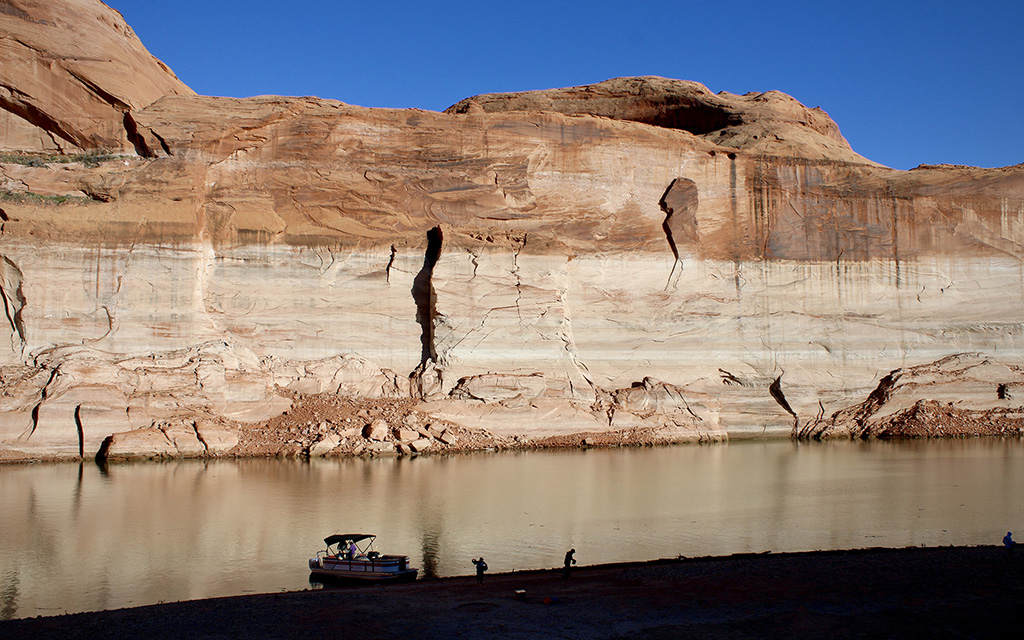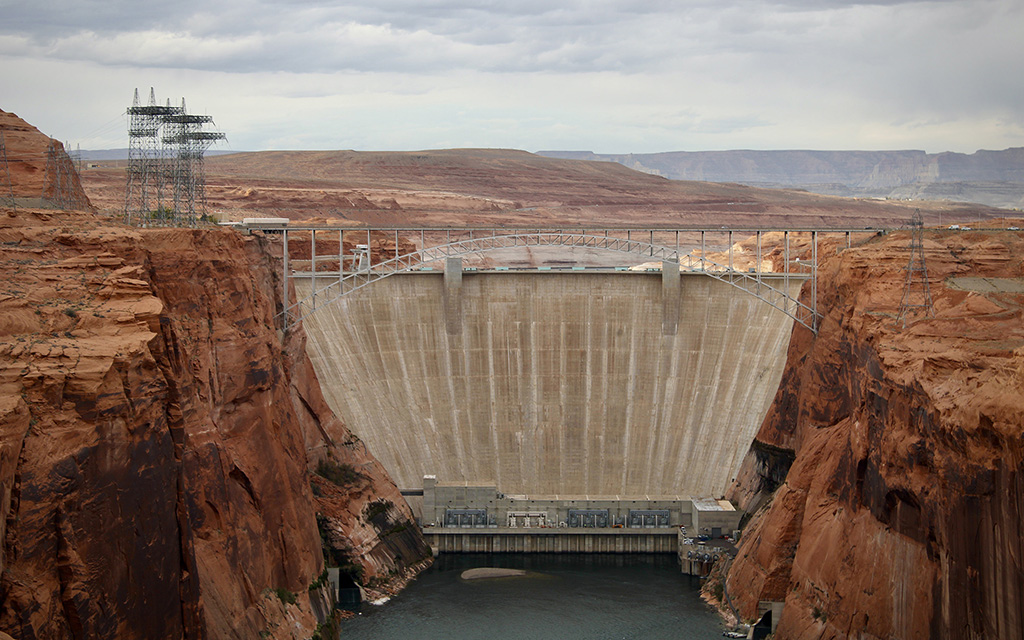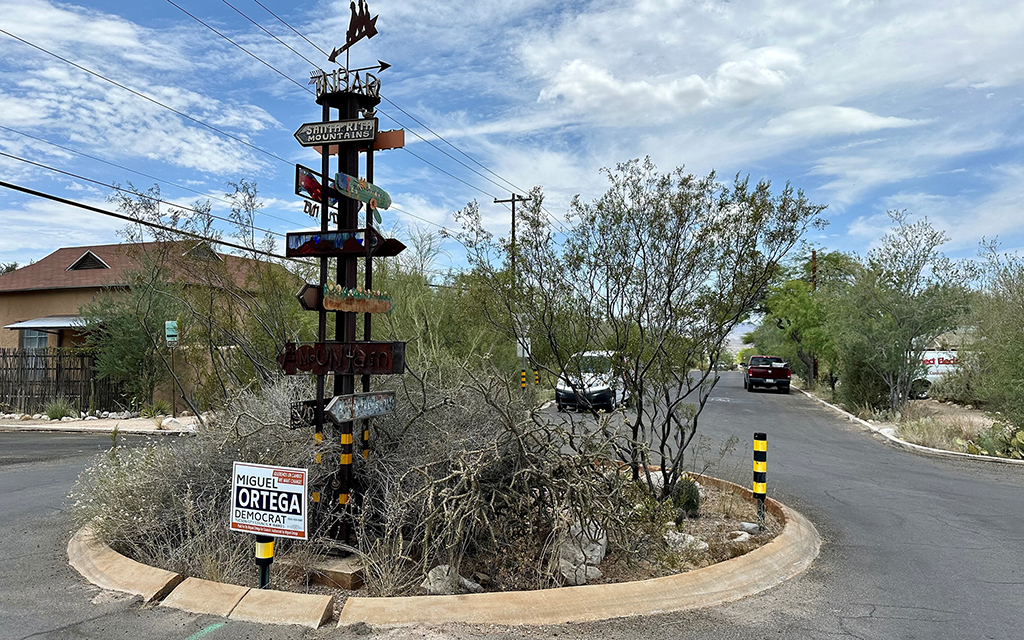
People unload a boat on the shores of Lake Powell in April. Lake Powell and Lake Mead, the nation’s largest reservoirs, saw a boost from winter snow, but Colorado River policymakers are still under pressure to find long-term changes to water demand in the Southwest. (Photo by Alex Hager/KUNC)
Federal officials are easing water restrictions after an unusually snowy winter in the mountains helped replenish the beleaguered river and its reservoirs and led to new Colorado River forecasts from the Bureau of Reclamation.
But the river’s users, which include Arizona and six other Western states, 30 Native American tribes and Mexico, are still under pressure to reduce demand.
“We are still on the precipice of a lot of uncertainty,” said Kyle Roerink, director of the nonprofit Great Basin Water Network. “The precarious nature of our modern water cycle should give all water managers pause. We just have to think, how are we going to live in a world where there’s going to be much less?”
Overall water levels in Lake Mead and Lake Powell have been declining for more than two decades, and experts widely agree that one wet winter will not be enough to correct the imbalance between supply and demand on the river’s water. But the snowy winter helped buy time for negotiators who will decide how the river’s water will be shared in the future, with current rules set to expire in 2026.
New projections from Reclamation – the federal agency that manages Western water – show Lake Mead’s water level falling just below 1,068 feet in January of next year. A shortage is triggered any time that number is below 1,075 feet.
Reclamation releases a new version of the 24-month study each month, projecting the next two years of water availability. The August study is used to determine if cutbacks are needed in the coming year.
In 2022, the agency’s August projections dealt the first-ever mandatory cutbacks to some water users and thrust the Colorado River’s supply-demand imbalance into the national spotlight. In 2023, those cuts were expanded.
This August study will roll back 2023’s water restrictions. New cuts, which will be put in place in 2024, are the same size as the cuts in place for 2022. Arizona will lose about 18% of its Colorado River supply and about 8% of the state’s total water use. Nevada will lose about 7% of its water allocation.
Current cutbacks are based on agreements written in 2007 and 2019.
The Central Arizona Project, which brings Colorado River water across the desert to supply the Phoenix area, will feel the brunt of Arizona’s cuts.
Brenda Burman, CAP’s director and a former Bureau of Reclamation commissioner, said the cuts are difficult for farmers in Pinal County, but will not have short-term impacts on homes and businesses in the Phoenix metro area.
“In 2024, you should not be concerned about the water coming out of your faucet,” Burman said. “But in the long term, you should know that we are in shortage. This is not something new. We expect that there is a smaller river.”
Human-caused climate change is making the western U.S. warmer, upsetting the natural processes that keep water flowing through the Colorado River. At the same time, the river is seeing steady demand from tens of millions of people from Wyoming to Mexico. More than 70% of that demand for water, however, comes from agriculture.
In the past four years, the amount of water stored in Lake Powell dropped particularly quickly. In April, water levels dipped to the lowest they’ve been since the reservoir was first filled in the 1960s.
Conservationists who campaign for the draining of Lake Powell celebrated the return of once-submerged geological features and animal habitat, but water managers scrambled to protect infrastructure reliant on certain reservoir levels.

The Glen Canyon Dam holds back Lake Powell in this 2022 photo. A string of particularly dry years led water managers to focus on protecting infrastructure in the dam. Now, they are expected to turn their focus to a long-term reworking of how the Colorado River is shared. (Photo by Alex Hager/KUNC)
Hydroelectric generators within Glen Canyon Dam, which holds back Lake Powell, depend on a steady flow of water to keep turbines spinning. During the recent stretch of dry years, electricity output decreased because of weaker flows, and if water levels dropped any lower, they would have fallen below the pipes that pull water into the generators and threatened irreparable damage.
A string of particularly dry years led water managers to focus on protecting infrastructure in the dam. Now, they are expected to turn their focus to a long-term reworking of how the Colorado River is shared.
“We’re going to be back to the brink soon enough,” Roerink said. “So anyone who’s resting on their laurels, whether it be folks in power markets or water users, I think are living in a fallacy.”
Decisions about where to store the region’s water were, for a few years, shaped by the urgent need to prop up Lake Powell, keeping those turbines spinning and keeping electricity flowing to about 5 million people across seven states.
This year’s boost to Lake Powell is expected to lift some of that urgency and let negotiators from each of the seven states that use the river focus on long-term decisions about the river’s future.
“All of us who rely on the river, who rely on our amazing infrastructure, have to be able to come to the table and show how they can live with less,” Burman said.
-This story is part of ongoing coverage of water in the West, produced by KUNC in Colorado and supported by the Walton Family Foundation. KUNC is solely responsible for its editorial coverage.
